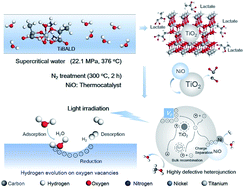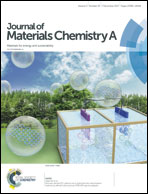Thermocatalytic syntheses of highly defective hybrid nano-catalysts for photocatalytic hydrogen evolution†
Abstract
Defects play important roles in many catalytic processes, particularly for photocatalytic processes in semiconductors as they can alter the band structures and affect the excited electron–hole recombination pathways/lifetimes of semiconductors. In this report, we described the development of a facile route to the production of highly defective photocatalysts. Firstly, organic species were bound onto the surface of a metal oxide semiconductor catalyst, followed by a relatively low temperature ageing in N2, to remove the organics and to attract oxygen molecules from the surface, generating oxygen vacancies. In particular, we introduced a co-catalyst during the syntheses, which acted as a thermocatalyst to promote full oxidation of the organics, leaving more oxygen vacancies at the surface and to form intimate heterojunctions with host-catalysts to further drive the photocatalytic hydrogen evolution. The hydrogen evolution rate for our developed NiO–TiO2 defective heterojunctions in a sacrificial system was measured at ca. 1.41 mmol g−1 h−1, which was much higher than those of comparable catalysts reported in the literature (that generally display hydrogen evolution rates <0.4 mmol g−1 h−1). Computational simulation, together with other analytical techniques, suggested that the generated surface oxygen vacancies could induce a series of impurity energy levels within the VBM and CBM of TiO2 that narrowed the electron transmission gap in the TiO2 and acted as active sites for the reaction between adsorbed H2O and photoinduced trapped electrons to produce H2.



 Please wait while we load your content...
Please wait while we load your content...